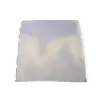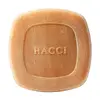LUSH Sleepy Soap Versus Hacci Honey Soap
What's inside
What's inside
 Key Ingredients
Key Ingredients

No key ingredients
 Benefits
Benefits

 Concerns
Concerns

 Ingredients Side-by-side
Ingredients Side-by-side

Brassica Napus Seed Oil
EmollientCocos Nucifera Oil
MaskingGoat Milk
Skin ConditioningPropylene Glycol
HumectantKaolin
AbrasiveWater
Skin ConditioningTalc
AbrasiveTitanium Dioxide
Cosmetic ColorantParfum
MaskingGlycerin
HumectantLavandula Angustifolia Oil
MaskingBenzoin Ethyl Ether
Dipteryx Odorata Seed Extract
MaskingCananga Odorata Flower Oil
MaskingSodium Chloride
MaskingSodium Hydroxide
BufferingEDTA
Tetrasodium Etidronate
Emulsion StabilisingBenzyl Benzoate
AntimicrobialBenzyl Cinnamate
PerfumingCinnamal
PerfumingCoumarin
PerfumingGeraniol
PerfumingLimonene
PerfumingLinalool
PerfumingCI 17200
Cosmetic ColorantCI 42090
Cosmetic ColorantBrassica Napus Seed Oil, Cocos Nucifera Oil, Goat Milk, Propylene Glycol, Kaolin, Water, Talc, Titanium Dioxide, Parfum, Glycerin, Lavandula Angustifolia Oil, Benzoin Ethyl Ether, Dipteryx Odorata Seed Extract, Cananga Odorata Flower Oil, Sodium Chloride, Sodium Hydroxide, EDTA, Tetrasodium Etidronate, Benzyl Benzoate, Benzyl Cinnamate, Cinnamal, Coumarin, Geraniol, Limonene, Linalool, CI 17200, CI 42090
Gum Base
Honey
HumectantWater
Skin ConditioningMyristic Acid
CleansingPalmitic Acid
EmollientPEG-3/PPG-2 Glyceryl/Sorbitol Hydroxystearate/Isostearate
EmulsifyingSqualane
EmollientIsostearic Acid
CleansingZea Mays Germ Oil
EmollientGlycyrrhizic Acid
HumectantSimmondsia Chinensis Seed Oil
EmollientParfum
MaskingCobalt Titanium Oxide
Skin ConditioningMica
Cosmetic ColorantEtidronic Acid
Ingredients Explained
These ingredients are found in both products.
Ingredients higher up in an ingredient list are typically present in a larger amount.
Parfum is a catch-all term for an ingredient or more that is used to give a scent to products.
Also called "fragrance", this ingredient can be a blend of hundreds of chemicals or plant oils. This means every product with "fragrance" or "parfum" in the ingredients list is a different mixture.
For instance, Habanolide is a proprietary trade name for a specific aroma chemical. When used as a fragrance ingredient in cosmetics, most aroma chemicals fall under the broad labeling category of “FRAGRANCE” or “PARFUM” according to EU and US regulations.
The term 'parfum' or 'fragrance' is not regulated in many countries. In many cases, it is up to the brand to define this term.
For instance, many brands choose to label themselves as "fragrance-free" because they are not using synthetic fragrances. However, their products may still contain ingredients such as essential oils that are considered a fragrance by INCI standards.
One example is Calendula flower extract. Calendula is an essential oil that still imparts a scent or 'fragrance'.
Depending on the blend, the ingredients in the mixture can cause allergies and sensitivities on the skin. Some ingredients that are known EU allergens include linalool and citronellol.
Parfum can also be used to mask or cover an unpleasant scent.
The bottom line is: not all fragrances/parfum/ingredients are created equally. If you are worried about fragrances, we recommend taking a closer look at an ingredient. And of course, we always recommend speaking with a professional.
Learn more about ParfumWater. It's the most common cosmetic ingredient of all. You'll usually see it at the top of ingredient lists, meaning that it makes up the largest part of the product.
So why is it so popular? Water most often acts as a solvent - this means that it helps dissolve other ingredients into the formulation.
You'll also recognize water as that liquid we all need to stay alive. If you see this, drink a glass of water. Stay hydrated!
Learn more about Water